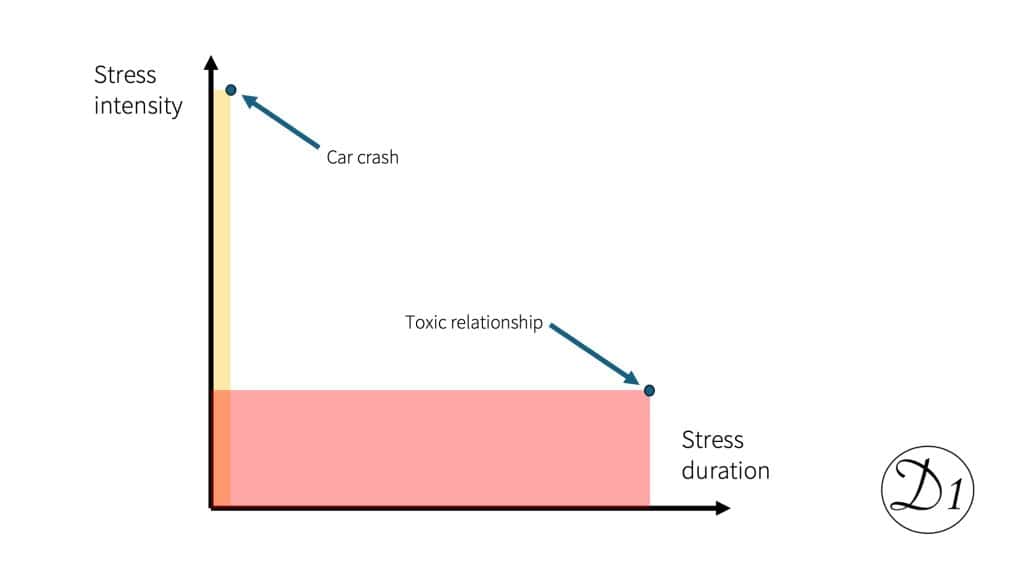Anxiety And Depression: How To Protect Yourself From What Harms You
If you burn yourself on a hot object, your reflexes automatically yank your hand away from it. Obviously, something similar should happen if something hurts you emotionally.
So, you have decided you want change. You want to leave your anxiety or depression behind. And now, it’s time to put thoughts into action. Clearly, the first thing to do is to protect yourself from the source of the problem. Stop doing what hurts you. Stop other people from hurting you. Get out of the situation that hurts you.
But it’s not always that easy.
(Featured image: Protecting yourself from the sources of your anxiety and depression is necessary but not necessarily easy.)
Stuck between a rock and a hard place?
Of course, there are uncountable possible reasons why you might suffer from anxiety or depression. And sometimes, it will seem hard to get out of the situation that makes you suffer.
For instance, if you are in a bad relationship, there can be a lot of social pressure to stay in it. You may not even want to leave yourself. Perhaps you love your partner, even if he makes you ill. And if you have children, it feels virtually impossible to exit.
Or perhaps your job is driving you insane, but it would feel like such a defeat to quit. And there may not be many alternatives; this is the only relevant job available to you in your area, the only one that pays enough to cover your mortgage.
I understand it can be difficult. And I can’t tell you exactly what to do. What I know, however, is:
- There is something that can be done in almost any situation.
- There are opportunities if we look for them.
- There is always hope.
I’ll return to this. However, to protect yourself from the source of your problems, it’s essential to identify the source. And that’s not always easy either. Let’s have a closer look at some of the circumstances that can be the source of anxiety or depression.
Abusive or toxic relationships
Humans are highly social animals, and bad relationships will always be one of the main reasons for stress and mental harm. Before I say anything else about this, I want to make one thing clear:
Physical or sexual abuse
If you are a victim of physical or sexual abuse, you need to get out! Now! Do you hear me?
There is no reason at all to believe that an abuser will change, even if he or she apologises and promises again and again.
Just skip everything else I write here and look for whatever help and support you can get to get out. People you can trust entirely, support centres, the police, just get a move on! Now!
Practical, financial, and legal challenges must be addressed afterwards once you’re safe.

‘Big T’ and ‘little t’ trauma
That said, abuse has many shapes and disguises. Although all of them are harmful, some may not be easily recognised as abuse. At this point, I’d like to remind you that ‘little t traumas’ can be just as harmful as ‘Big T traumas’.
What is this about? Trauma, in this context, is a mental wound we suffer after having experienced highly stressful circumstances. Now, there are (at least) two things to consider regarding the impact stressful circumstances have on us: the intensity and the duration.
Different people might react quite differently to the same situation, so let’s imagine that one person experiences two situations: a car crash and being in a toxic relationship for five years. The car crash had a shocking intensity, but the duration was minimal. The toxic relationship wasn’t life-threatening in any way, but it went on and on.

The ‘Big T trauma’ of the car crash (illustrated by the yellow area) had a much smaller impact on this person than the ‘little t trauma’ (red area) of the toxic relationship.
Emotional abuse
So, let’s have a quick look at some of the types of emotional abuse that can leave us seriously traumatised in the long run:
- Sarcasm, criticism and humiliation: Some people feel ‘big’ and valuable only when making others feel ‘small’ and worthless.
- Isolation: For instance, a partner pressures you to stop seeing your friends, or some colleagues at work are giving you ‘the silent treatment’.
- Shame and blame: Making you believe ‘everything’ is always your fault.
- Backbiting: Talking disrespectfully about you behind your back.
- Emotional neglect: For instance, someone you depend on refuses to meet your emotional needs and makes your concerns feel unimportant.
Never underestimate the impact persistent ‘little t trauma’ can have on you. And please don’t compare your reactions to how others react to the same situation.
It’s time for a serious conversation, then, or what?
Oh, you’re thinking of sitting down and explaining to the abuser how their behaviour has hurt you? And they will say, “I’m so sorry I’ve hurt you. What can I do to make it right? It will never happen again, I promise!”
This might happen, I suppose. But the probability is very, very low. In my experience, most emotional abusers aren’t even aware of how they behave or how their behaviour affects others. It’s more likely you will hear something like this:
- “How can you be offended by such a small thing?”
- “I was just joking, okay?”
- “What are you talking about? You must have misunderstood everything I said.”
- “No one else has ever been offended by this.”
From their perspective, this might even be partially true. Few emotional abusers make a conscious decision to hurt others. It’s just in their nature to behave this way, and they feel entitled to do so.
However, all abuse is about power and control, consciously decided or not. If we are speaking of long-term abuse, the probability of successfully changing the abuser’s behaviour and personality is extremely low. People who enjoy having power over others won’t be much interested in giving that up.
You must, at least, decide how much you can afford to invest in trying, regardless of the relationship type—partnership, friendship, professional, or family.

Other sources of anxiety or depression
Of course, it’s impossible to provide an exhaustive list. However, the few things I mention below are in some ways similar to the long-term trauma of toxic relationships. They can all be sources of persistent stress, which might, sooner or later, create the foundations for anxiety or depression.
Overdemanding work or education conditions
To be challenged isn’t a bad thing. We get bored and distracted if we don’t find enough challenges in our work or studies. With the perfect balance between challenges and skills, we experience ‘flow’, which is a wonderful thing. We are ‘in the zone’.
However, a long-term imbalance between the demands placed on us and our skills and resources (time, for instance) means constant stress, which often leads to burnout, loss of self-esteem, anxiety, and depression.
Loneliness
While living in abusive relationships is bad enough, being lonely isn’t much better. It’s scientifically proven that loneliness has negative consequences for both physical and mental health.
Remember that you don’t have to be alone to feel lonely. Understanding this difference might be crucial to identifying the sources of your anxiety or depression. Some people can thrive while living on their own. Others will be desperately lonely even in a relationship.
Loneliness is caused by a lack of meaningful and deep connections, trust, and safety, not by the number of people around you.

Bereavement
Bereavement can come in many forms. The most obvious, of course, is if someone dear to us passes away, for instance, parents, friends, or a beloved pet.
We can also be firmly attached to possessions (for instance, a family home), relationships (a friendship since childhood), or even an old habit we must give up.
Whenever we lose something of emotional value, a grief process may be triggered. This is natural and necessary. However, we sometimes get stuck in this process, and this can be a source of anxiety or depression.
Illness or disability
Few things are harder to lose than our health, our lives, or our lives as we knew them. Illness and disability may be a significant source of anxiety and depression.
I am, of course, not only talking about illness or disability that affects us directly. People whose parents are suffering from dementia often feel they’re losing their mothers or fathers twice. Most parents who have seen their children suffer would rather take the suffering upon themselves if this had been possible.
And I can personally guarantee that the possibility of a child’s death is the worst horror imaginable.
Okay, what can we do, then?
All of this seems rather grim. So, what can we do to protect ourselves from the sources of our anxiety and depression? We can’t always just leave a toxic relationship or a crap job, and there’s no magic spell we can use to make loneliness, loss, or illness disappear.
There is, however, another question we have to ask first:
When does a problem become a problem?
If we are looking for the sources of our anxiety and depression and how to protect ourselves from them, it’s essential to understand how and why unfortunate circumstances might trigger anxiety and depression.
Because one person comes out of a car crash bruised but otherwise unaffected. The guy in the seat beside him suffers from PTSD for years. One person shrugs a decade-long toxic relationship off her shoulders; another person is seriously harmed by it. One person grieves the loss of a loved one and gets on with life; another never recovers.

Why the differences? Personally, I believe this very often comes down to one thing:
A feeling of helplessness
Stress is a natural response to perceived danger. It is the mind’s/body’s preparation for fight or flight. Of course, the stress response is meant to go away when the threat is gone. Still, in many of us, it stays and transforms into anxiety and depression.
In most cases, or so I sincerely believe, this happens because we feel helpless, believing we cannot do anything about our circumstances.
I would be rather arrogant if I thought I had the one solution for everyone who needs to protect themselves from the sources of their anxiety or depression. However, I think I’m on to something here.
If we suffer from anxiety or depression because we feel helpless, why do we feel helpless? If we believe we can do nothing with our situation, is it really so?
Learned helplessness
It’s possible to imagine ourselves in extreme, dangerous situations where we are entirely helpless, but in most real-life situations, we aren’t. Consider the possibility that your perceived helplessness can be learned helplessness. SimplyPsychology describes learned helplessness like this:
Learned helplessness is a psychological state in which an individual, after repeated exposure to uncontrollable negative events, believes they are powerless to change their situation, even when opportunities to do so arise.
This leads to passivity, decreased motivation, and a sense of hopelessness, which can persist even when circumstances change and control is possible.
Learned helplessness is often associated with depression.
Detangling helplessness
To protect yourself from the sources of your anxiety and depression, my advice is to start by looking at your feelings of helplessness. Check in with your self-talk. What are you saying to yourself internally? Things that are less than pleasant? If so, whose voice do you think you’re hearing? Is it your own voice? Are you sure? If you have been a victim of emotional abuse, I can promise that the abuser, consciously or unconsciously, has put a lot of effort into making you feel helpless.
If your learned helplessness isn’t a result of emotional abuse, try to realise that even if things have gone wrong in the past, perhaps repeatedly, it’s not written in the stars that they will continue to go wrong. The only way to ensure failure is not to try. Set manageable goals for yourself. To unlearn helplessness, achieving something before you start raising the bar is essential.

Creating distance
When you can see you’re not entirely helpless, try to look for ways to distance yourself from the source of the problem. Remember, distance doesn’t necessarily mean geographical distance, even though this might be preferable. Distance can also mean emotional distance and personal boundaries.
When I say ‘emotional distance’, I mean that you find ways not to get hurt that easily. If you have identified that emotional abuse is the source of your problem, that realisation is a huge step in itself. The next time sarcasm or blaming rains over you, you can say, at least inwardly, “It’s not true. I don’t believe you anymore.” You may be surprised by the difference this will make.
When I say ‘personal boundaries’, I mean that you actually tell the world what you accept and not accept. Perhaps quietly at first. Perhaps in small portions. That’s okay. It may also surprise you that setting boundaries is possible, more often than not, if you dare to try.
Plan the rest of the journey
With some physical or emotional distance established, you will have created room to plan the next steps of your journey out of anxiety or depression. Remember:
- There is something that can be done in almost any situation—but we can’t always solve the problem immediately. We may have to work towards it in a long-term perspective.
- There are opportunities if we look for them—but we might have to look at the situation from a new perspective to discover them. For instance, “I’m not as helpless as I thought.”
- There is always hope—provided we don’t give up.
(All pictures used in this article are AI-generated.)















Post Comment
You must be logged in to post a comment.